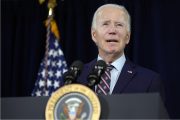“After their meeting at the White House on Wednesday, Obama was careful to stick to diplomatic language in [getting] his message across that both the Afghan and Pakistani presidents need to do more to confront the threat posed by the Taliban and al Qaeda.”
Item: An interview in the Atlantic Monthly with former Congressman Lee Hamilton about Obama’s foreign policy included Hamilton’s response that “the tone and rhetoric of American foreign policy is different. The President clearly supports diplomacy and engagement, and he has attempted to change the country’s operating environment. His foreign policy is pragmatic, realistic, and visionary at the same time.”
Correction: Both the media and enthusiastic supporters of President Barack Obama have repeatedly described him as a pragmatic realist on foreign policy, which they contend is a huge departure from the ideologically driven Bush administration. Vice President Joe Biden described Obama as “a clear-eyed pragmatist” and the president himself stated that his national security team shares his pragmatism. Merriam-Webster’s dictionary defines pragmatism as “a practical approach to problems and affairs.”
Sadly, “practical” is not the word an unbiased observer would use to describe Obama’s drastic escalation of America’s land war in Central Asia. The two nations in which the United States is progressively intervening, Afghanistan and Pakistan, are collectively being referred to as “Af-Pak.” A serious inspection of Obama’s Af-Pak policy seems virtually indistinguishable from the neoconservative policy of the Bush administration. Instead of an exit strategy, our involvement appears open-ended with no clear-cut understanding of what is to be achieved by propping up the Afghan or Pakistani regimes. What’s pragmatic about that?
Obama’s Iraq-style troop surge in Afghanistan aims to increase troop levels there up to 68,000. This is a sharp rise from around 38,000 in February. It’s not just troop levels that Obama is boosting; the new commander in chief also is breaking records with bombing raids. The Navy Times reported on May 4:
Air Force, Navy and other coalition warplanes dropped a record number of bombs in Afghanistan during April, Air Forces Central figures show. In the past month, warplanes released 438 bombs, the most ever…. The actual number of air strikes was higher because the AFCENT [Air Force Central] numbers don’t include attacks by helicopters and special operations gun ships. The numbers also don’t include strafing runs or launches of small missiles.
The increased intensity of Obama’s Afghanistan strategy has resulted in one unmistakable result — a sharp spike in civilian deaths. On May 6, the New York Times reported that “American air strikes … had killed dozens and perhaps more than 100 civilians in western Afghanistan…. If the higher toll proves true, the bombardment, which took place late Monday, will almost certainly be the worst in terms of civilian deaths since the American intervention began in 2001.” Coalition deaths are also on the rise and climbing steadily from January through March 2009.
Afghanistan President Hamid Karzai has been critical about the rising civilian death toll under the new administration and has gone so far as to request a halt of air strikes. The administration responded firmly with a “no.” On May 10, the Washington Times reported that White House National Security Adviser James Jones stated, the “United States will not end air strikes in Afghanistan as demanded by President Hamid Karzai after two villages were hit by U.S. warplanes last week.”
Obama’s aggressive approach to Afghanistan includes former Vice President Dick Cheney, an outspoken neoconservative, as a strong supporter. In an interview on the CBS program Face the Nation, Cheney praised Obama’s war escalation:
I think we have to be committed there for a long period of time. I was glad to see President Obama commit additional troops to Afghanistan. I think we need to do whatever we have to do there to be able to prevail. Air strikes are an important part of it.
Oddly enough, the original reason given for invading Afghanistan, to combat al-Qaeda — the terrorist organization behind the 9/11 attacks — seems to no longer be a motivating factor for augmenting the military effort in the area. General David Petraeus, the chief of the U.S. Central Command, now says al-Qaeda no longer is operating in Afghanistan. One must ask then, what is our purpose in the region? Is it now exclusively a nation-building campaign of spreading democracy as envisioned by the neoconservatives?
Obama has not been content to solely escalate the war in Afghanistan; the man who ran for office as a “peace candidate” widened the conflict into Pakistan almost immediately after he was sworn into office. Referring to the events in Pakistan as a “covert war,” the New York Times reported that Obama seeks to expand these actions by the CIA and sharply increase drone attacks. The president is using drone strikes by unmanned planes to bomb the northwestern region of the country. There have been 14 attacks in 2009, with five taking place in April. An April 19 attack in South Waziristan resulted in the deaths of eight civilians, many of whom were women and children. Shortly after that, another attack followed, which villagers said struck a school and resulted in at least 10 deaths, with officials reporting that the toll is likely to rise. The increasing U.S. intervention in the region has also contributed to the instability of the Pakistani government as it now launches a new effort to crackdown on Taliban militants. The Independent reports that “half a million people are being displaced by Pakistan’s military operations against the Taliban.”
The new administration doesn’t appear to see a near end to our involvement in the Af-Pak region. The Business Standard reports that the annual 2010 U.S. budget “unveiled by the Obama Administration … refocuses significantly on fighting insurgency in Pakistan and Afghanistan and increases non-military aid to both nations…. In line with President Barack Obama’s Af-Pak strategy, it expands [the] number of civilian personnel in the two countries to help stabilise them and build government capacity.”
Obama, whose opposition to the Iraq invasion in 2002 helped propel him into national politics, famously decried the war:
I know that even a successful war against Iraq will require a US occupation of undetermined length, at undetermined cost, with undetermined consequences. I know that an invasion of Iraq … will only fan the flames of the Middle East, and encourage the worst, rather than best, impulses of the Arab world, and strengthen the recruitment arm of al-Qaeda.
Now that Obama has become the president of the United States, he appears determined to follow the same bloody path he criticized only a few years ago. In a debate with Hillary Clinton during the Democratic primaries, Obama said, “I don’t want to just end the war, but I want to end the mindset that got us into war in the first place.” About what mind-set was Obama speaking? The mind-set that “democracy” can be spread at the point of the gun? The mind-set that terrorism can be fought with military occupation of far-away lands? The mind-set that open-ended nation-building campaigns can be accomplished with more boots on the ground and bombs from above? The president’s Af-Pak policy consists of increasing U.S. intervention at all levels without any clear benchmarks for success or a timetable for withdrawal — dangerously similar to the neoconservative approach that resulted in the Iraq quagmire.
Obama has repeatedly held himself out to be a man of peace. The media only embellishes this misconception by proclaiming him to be a “realist” and “pragmatic,” in such a sharp contrast from the neoconservative warmongers. A brief review of U.S. foreign policy under Obama after just four months in office only highlights the deception of both the administration and the American media.
— Photo: AP Images


